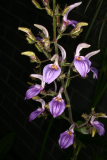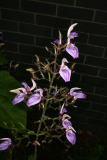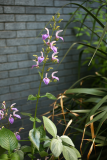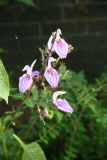Additional notes (click to expand)
Commemorative
Brillantaisia: for M. Brillant-Marion, 19th century French botanist who accompanied Ambroise Marie François Joseph Palisot de Beauvois in West Africa. The genus Brillantaisia in the Acanthaceae was published in 1818 by Palisot de Beauvois. (Botanary; The Names of Plants by Gledhill)
http://www.calflora.net/southafrica/1A-B.html
Nomenclature
Syn: Brillantaisia subulugurica; Brillantaisia kirungae
Synonym of Brillantaisia cicatricosa
http://www.plantsoftheworldonline.org/
Other use
Brillantaisia ulugurica Lindau, Acanthaceae. Giant salvia. Tropical herbaceous plant. Distribution: Tropical Africa. Brillantaisia patula is used by the Yoruba in south Nigeria for small-pox medication, the roots being mixed with Bahia nitida and Marantolchloa leucantha, Piper guineense and snails. This is made into a soup and the snail piece eaten to protect against smallpox for a year (Neuwinger, 1994) which doubtless was efective after the global eradication of smallpox in 1979. Brillantaisia nitens is used in the Cameroons to treat cardiovascular disorders. Phytochemical screening of Brillantaisia species have shown antibacterial action, vascular smooth muscle relaxant properties. Kew reports their use as soap, skin leaves for a foot itch, as a medication in pregnancy (S. Nigeria).
Oakeley, Dr. Henry F. (2013). Wellcome Library notes.
link
Geographical distribution
- Africa, East Tropical Africa, Tanzania
- Africa, East Tropical Africa, Uganda
- Africa, West-Central Tropical Africa, Congo
Brillantaisia ulugurica Lindau
Family: ACANTHACEAEGenus: Brillantaisia
Species: ulugurica Lindau
Common names: Giant Salvia
Distribution summary: East Africa
Habit: Shrub
Hardiness: H2 - Tender; cool or frost-free greenhouse
Habitat: Understorey and margins of evergreen forest
Garden status: Not currently grown
Reason for growing: Other use
 - Copy.JPG)
.JPG)




.JPG)
.JPG)
.JPG)
.JPG)